-
Membership
Membership
Anyone with an interest in the history of the built environment is welcome to join the Society of Architectural Historians -
Conferences
Conferences
SAH Annual International Conferences bring members together for scholarly exchange and networking -
Publications
Publications
Through print and digital publications, SAH documents the history of the built environment and disseminates scholarship -
Programs
Programs
SAH promotes meaningful engagement with the history of the built environment through its programs -
Jobs & Opportunities
Jobs & Opportunities
SAH provides resources, fellowships, and grants to help further your career and professional life -
Support
Support
We invite you to support the educational mission of SAH by making a gift, becoming a member, or volunteering -
About
About
SAH promotes the study, interpretation, and conservation of the built environment worldwide for the benefit of all
Naples and Campania, Day Three, 15 May 2008
by: Mia Reinoso Genoni
miagenoni@post.harvard.edu
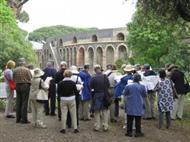
On Thursday we turned our attention to Pompeii, buried by Vesuvius in 79 CE. Beginning at the amphitheater, we tried to get a good sense of the urban planning of the city, with the intensity of our efforts documented in this picture. The amphitheater itself is perfectly captured here, in all of its startling completeness. This site was well-chosen as an entrance point, as we discussed how the amphitheater testifies to Roman colonial strategies. Retired soldiers were given land and rights and sent to populate colonial holdings; as these soldiers were trained in gladiatorial games amphitheaters were a necessity of colonial policy and urban planning. Also fascinating is the evidence of flora unearthed in areas like the palaestra, next to the amphitheater, and the surrounds: after the eruption of Vesuvius, cavities of plant roots remained, and casts made from them allow ethnobiologists to have an extensive knowledge of ancient Roman flora

Pompeii provides significant evidence in regards to gardens, more important and integral in Roman society than in Greek. Here we see the peristyle garden of the House of the Gilded Cupids (Amorini Dorati). This garden would probably have featured boxwood, which Pliny praises as an aid for sight and memory, and arbutis, an edible red berry. In gardens such as this, hairpins and perfume ampules have been found, testifying to the presence of women tending the garden and the harvesting of herbs to make scents.
.jpg?sfvrsn=4e74fb52_2)
Of the many, many sites of Pompeii, the visit to the Villa of the Mysteries stands out as a phenomenal experience. The famous frescoes are often reproduced but attempts to capture them often make the room seem much bigger than it is. This photo gives a better sense of the intimate scale of the room.
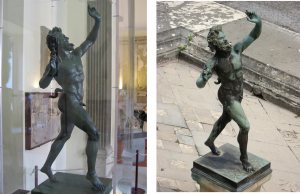
This great image compares the original statue in the House of the Faun (left), now in the National Archaeological Museum of Naples, along with the copy placed in situ (right). A comparison of this sort is only possible on a trip that has the scope of this tour, visiting Pompeii and the institutions of Naples in one swoop.
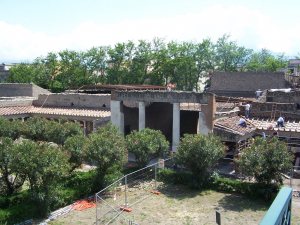
From the busy and extensive city of Pompeii we turned to a luxury Roman settlement, the Villa Oplontis in Torre Annunziata, which in many ways is comparable to the Villa San Marco we visited previous day. It is datable to 100 BCE-79 CE.
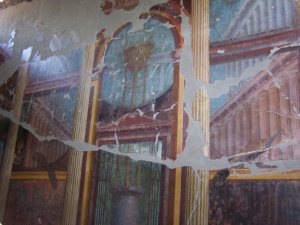
The Villa Oplontis answers questions and, at the same time, poses new ones. In Pompeii the only second style wall paintings are in tiny houses, so it was originally believed that they were primarily meant to function as trompe l’oeil works to create the illusion of space. This hypothesis was challenged upon discovery of the second style paintings in the spacious rooms of the Villa Oplontis, such as this image of a sanctuary of Apollo, located in the sitting room.
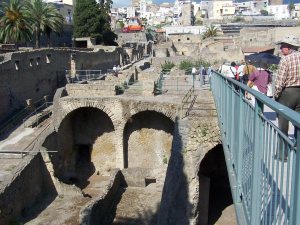
Logically, we rounded off the day with a trip to Herculaneum, which was probably a luxury suburb of Naples. Much less of the area has been excavated in comparison to Pompeii. From this photo of the entrance ramp, you can see how much lower the sea level was at the time of the eruption of Vesuvius than it is today.
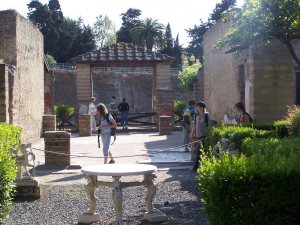
The change in sea level is also apparent in a view from the House of the Stags, as is the importance of the garden and the sumptuousness of the furnishings.
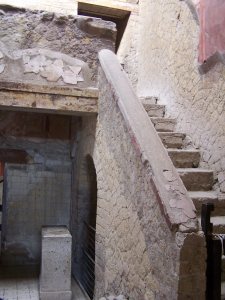
One of the most exciting things about Herculaneum is that structures of two stories were preserved, such as the House of the Beautiful Courtyard, seen here.
Thanks to David Steward, SAH Life Member, of the Center for Urban Earthquake Engineering, CUEE, Tokyo Institute of Technology, for bringing to my attention a great article on the eruptions of Vesuvius through the millennia: “Vesuvius Countdown” by Stephen S. Hall, National Geographic (Sept. 2007):
http://ngm.nationalgeographic.com/2007/09/vesuvius/vesuvius-text.html
miagenoni@post.harvard.edu

On Thursday we turned our attention to Pompeii, buried by Vesuvius in 79 CE. Beginning at the amphitheater, we tried to get a good sense of the urban planning of the city, with the intensity of our efforts documented in this picture. The amphitheater itself is perfectly captured here, in all of its startling completeness. This site was well-chosen as an entrance point, as we discussed how the amphitheater testifies to Roman colonial strategies. Retired soldiers were given land and rights and sent to populate colonial holdings; as these soldiers were trained in gladiatorial games amphitheaters were a necessity of colonial policy and urban planning. Also fascinating is the evidence of flora unearthed in areas like the palaestra, next to the amphitheater, and the surrounds: after the eruption of Vesuvius, cavities of plant roots remained, and casts made from them allow ethnobiologists to have an extensive knowledge of ancient Roman flora

Pompeii provides significant evidence in regards to gardens, more important and integral in Roman society than in Greek. Here we see the peristyle garden of the House of the Gilded Cupids (Amorini Dorati). This garden would probably have featured boxwood, which Pliny praises as an aid for sight and memory, and arbutis, an edible red berry. In gardens such as this, hairpins and perfume ampules have been found, testifying to the presence of women tending the garden and the harvesting of herbs to make scents.
.jpg?sfvrsn=4e74fb52_2)
Of the many, many sites of Pompeii, the visit to the Villa of the Mysteries stands out as a phenomenal experience. The famous frescoes are often reproduced but attempts to capture them often make the room seem much bigger than it is. This photo gives a better sense of the intimate scale of the room.

This great image compares the original statue in the House of the Faun (left), now in the National Archaeological Museum of Naples, along with the copy placed in situ (right). A comparison of this sort is only possible on a trip that has the scope of this tour, visiting Pompeii and the institutions of Naples in one swoop.

From the busy and extensive city of Pompeii we turned to a luxury Roman settlement, the Villa Oplontis in Torre Annunziata, which in many ways is comparable to the Villa San Marco we visited previous day. It is datable to 100 BCE-79 CE.

The Villa Oplontis answers questions and, at the same time, poses new ones. In Pompeii the only second style wall paintings are in tiny houses, so it was originally believed that they were primarily meant to function as trompe l’oeil works to create the illusion of space. This hypothesis was challenged upon discovery of the second style paintings in the spacious rooms of the Villa Oplontis, such as this image of a sanctuary of Apollo, located in the sitting room.

Logically, we rounded off the day with a trip to Herculaneum, which was probably a luxury suburb of Naples. Much less of the area has been excavated in comparison to Pompeii. From this photo of the entrance ramp, you can see how much lower the sea level was at the time of the eruption of Vesuvius than it is today.

The change in sea level is also apparent in a view from the House of the Stags, as is the importance of the garden and the sumptuousness of the furnishings.

One of the most exciting things about Herculaneum is that structures of two stories were preserved, such as the House of the Beautiful Courtyard, seen here.
Thanks to David Steward, SAH Life Member, of the Center for Urban Earthquake Engineering, CUEE, Tokyo Institute of Technology, for bringing to my attention a great article on the eruptions of Vesuvius through the millennia: “Vesuvius Countdown” by Stephen S. Hall, National Geographic (Sept. 2007):
http://ngm.nationalgeographic.com/2007/09/vesuvius/vesuvius-text.html



Leave a commentOrder by
Newest on top Oldest on top